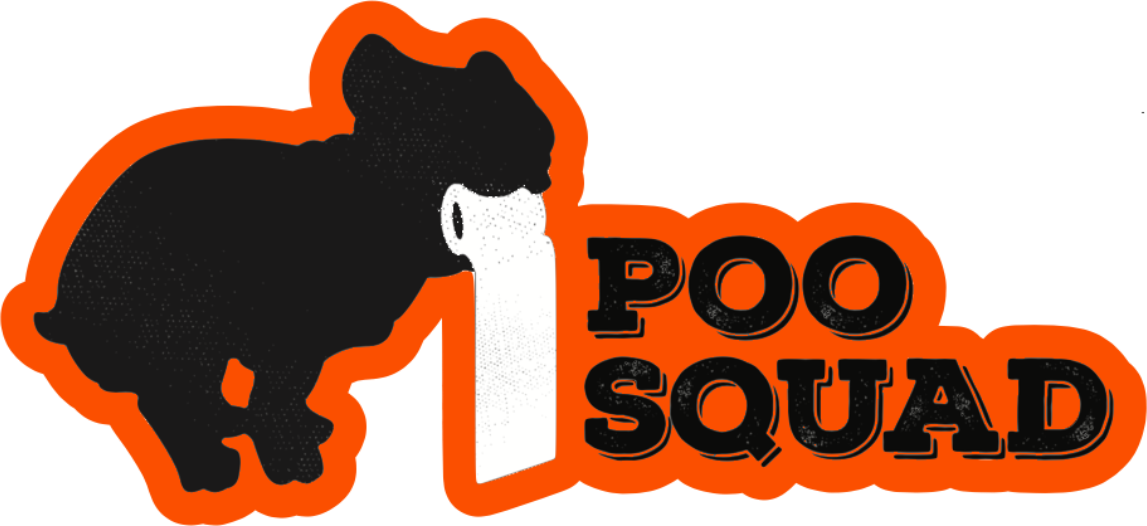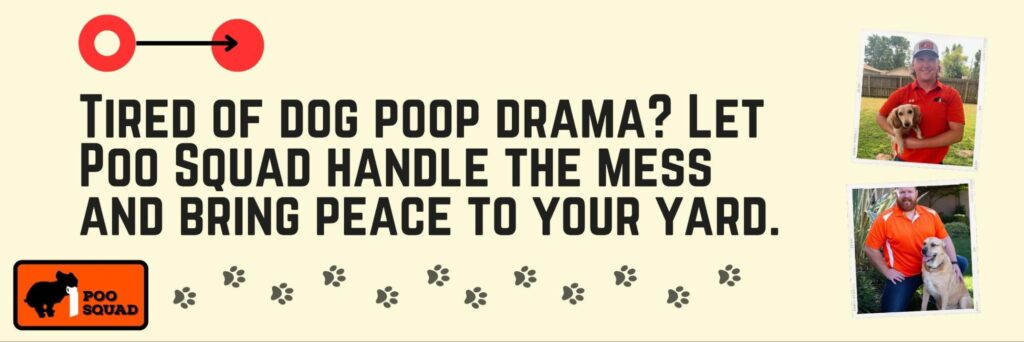Is White Dog Poop Dangerous? What It Really Means
White dog poop can signal excess calcium, poor digestion, or even liver or gallbladder problems. If it’s dry and crumbly after a bone, it’s likely harmless. But if it persists, looks greasy, or comes with symptoms like vomiting or fatigue, it’s time to call your vet.
The first time you see a pale pile in the yard, it’s easy to think it’s sun-bleached or bone-related, and sometimes it is. But chalky, greasy, or consistently pale poop can also hint at bile issues, enzyme deficiency, or other medical concerns you don’t want to overlook.
Want to know what causes white dog poop, how to tell if it’s dangerous, and what to do next? We’ll break it all down, plus show you how to stay ahead of the problem before it affects your dog’s health (or your weekend).
What Causes White Dog Poop in the First Place?
If your dog’s poop suddenly looks like a scoop of white plaster, it’s not random. White dog poop can come from what they’re eating, how their body’s working, or even what the weather’s doing outside. Let’s unpack the usual suspects.
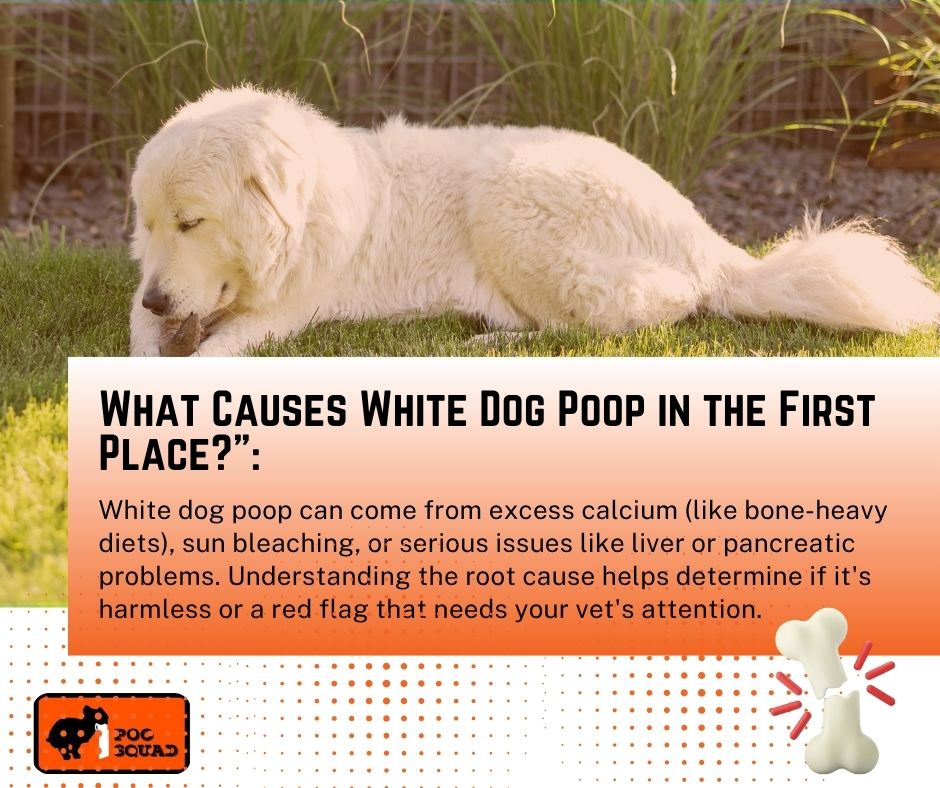
1. High-Calcium Diets and Bone Overload
Dogs on raw or bone-heavy diets often leave behind white, chalky droppings. The excess calcium doesn’t fully digest and shows up in their stool like someone dumped drywall in the yard.
Why does my raw-fed dog’s poop turn white?
Short answer: bones. Especially if your dog’s scarfing down marrow bones or turkey necks like treats, you’ll see pale poop soon after.
If those stools are also dry and crumbly, constipation might not be far behind. A little calcium is fine, too much and your pup’s plumbing could slow down to a crawl.
2. Sunlight, Snow, and the Great Outdoors
Sometimes it’s not the poop, it’s the weather. Sunlight bleaches feces over time, especially in warmer months. In winter, snow can leach out color and leave behind ghostly white clumps.
We’ve had clients swear up and down they’ve found trash or ash in their yard, only to realize aged dog poop that missed a scoop. If the pile’s been there a while, the color alone doesn’t always mean danger, but it does mean your cleanup crew’s overdue.
3. Liver and Gallbladder Dysfunction
Pale, clay-like poop that shows up suddenly (and doesn’t go away) is a possible sign of liver or gallbladder problems. When the body stops producing bile, or the bile gets blocked, stool loses its normal brown color and turns a sickly light gray or white.
Conditions like gallstones, hepatitis, or a bile duct obstruction can all cause this. If you’re thinking, “My dog’s poop turned pale overnight, do I need a vet?” the answer is yes. This isn’t one to watch and wait on.
4. Pancreatic or Digestive Disorders
Not all light-colored poop is calcium-related. Dogs with pancreatic conditions like EPI (Exocrine Pancreatic Insufficiency) or malabsorption issues often have pale, greasy stools that smear instead of scoop.
Fat that doesn’t digest properly leaves a noticeable signature, loose, shiny poop that sometimes floats. Odd-looking; it’s a signal your dog’s not getting the nutrients they need.
When Is White Dog Poop a Health Red Flag?
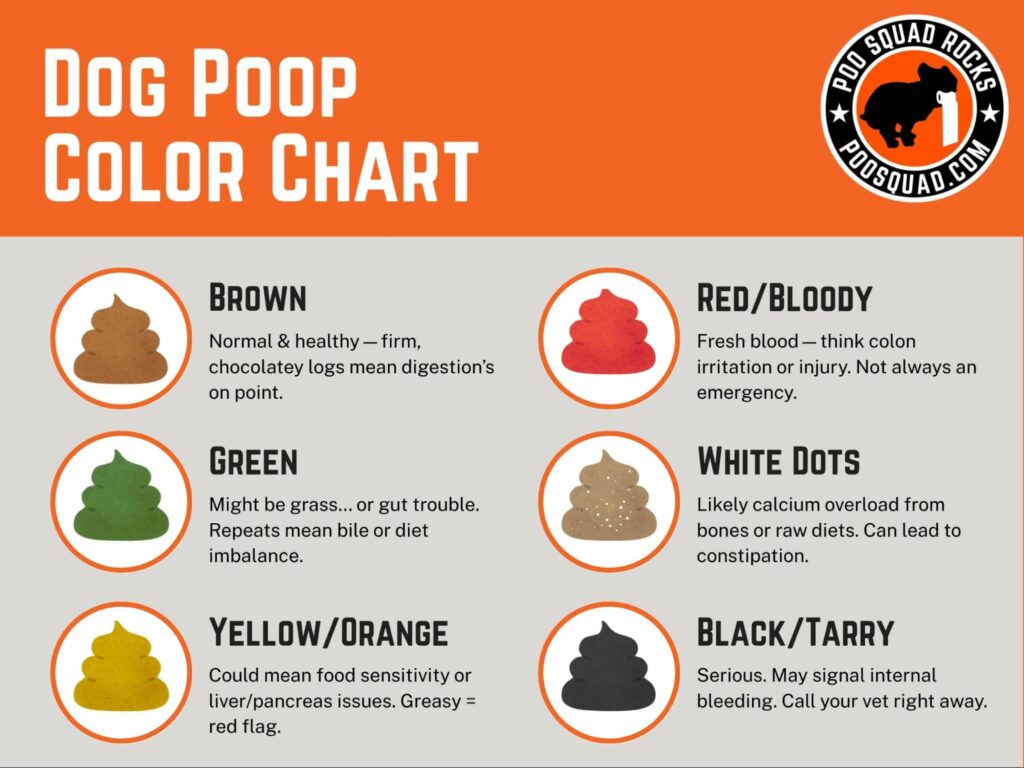
Not every weird-looking turd is a crisis, but certain signs mean it’s time to dig deeper. White stool can range from harmless to urgent, here’s how to tell which side of the line you’re on.
1. The “Persistence Test”
One pale pile?
‘Could be leftover bone from last night’s chew session or sun-bleached poop hiding behind the grill. But if the color sticks around for more than a day or two, your dog might be waving a silent red flag.
A pattern is what matters. That’s why reports that track poop consistency over time can be surprisingly helpful. If every visit shows the same chalky output, it’s not a coincidence, it’s a trend. And that trend might need a vet’s opinion.
2. Accompanying Symptoms to Watch For
White stool by itself might not mean much. But pair it with vomiting, fatigue, bloating, or appetite loss, and you’ve got a possible emergency.
“My dog had white poop and stopped eating, what now?” If you’re asking that, don’t wait. Dogs hide discomfort well, and poop changes often show up before they act sick. When other symptoms join the party, it’s time for a vet visit without delay.
3. Should I Be Worried If My Puppy Eats White Poop?
Puppies will eat about anything. That includes old, dried-out poop they find in the yard, especially if it’s turned pale from sun or snow. But even “aged” poop can harbor bacteria or parasites.
If your pup’s into scavenging white poop. It could lead to digestive issues, worm infections, or worse. And if you’re wondering whether to let it slide or call someone, the safe move is to call.
4. Is It Worms or Just Calcium?
Some folks confuse “white poop” with “poop that has white specks.” Not the same thing.
Full white logs are usually calcium-heavy or bile-deficient. Tiny white grains, especially if they wiggle, are a sign of tapeworms. They look like little pieces of rice, not chalky piles.
If you’re trying to figure out whether you’re dealing with bones, bile, or bugs, it often comes down to texture and shape. And if you’re still unsure, the vet can tell in one test.
Common Myths About White Dog Poop
A lot of people brush off white dog poop without giving it a second glance. But letting old myths steer your judgment can mean missing early signs of something serious. Let’s clear the air.
1. “It’s Just Fertilizer, Right?”
This one’s surprisingly common. Folks assume dog poop breaks down like cow manure and helps the grass grow. Not even close.
Dog feces carries an average of 23 million coliform bacteria per gram. That includes pathogens like E. coli and salmonella. Instead of feeding your lawn, it can burn your grass, poison nearby soil, and put kids and pets at risk.
Cleaning up is about more than appearance. It’s about keeping outdoor spaces healthy and safe.
2. “Only Rich People Pay Attention to This Stuff”
Paying attention to poop isn’t about wealth, it’s about awareness. Several customers have caught early-stage health issues in their pets simply by noticing unusual poop color or texture.
White poop may look harmless, but dismissing it can delay care that makes a real difference.
The truth?
Anyone who picks up after their dog regularly is already halfway to being a poop detective.
3. “I Thought It Was Just Snow Bleach”
Winter makes everything look a little off. White snow, low light, and cold temps can bleach dog poop in a day or two. But not all white poop is weather-related.
Here’s how to spot the difference:
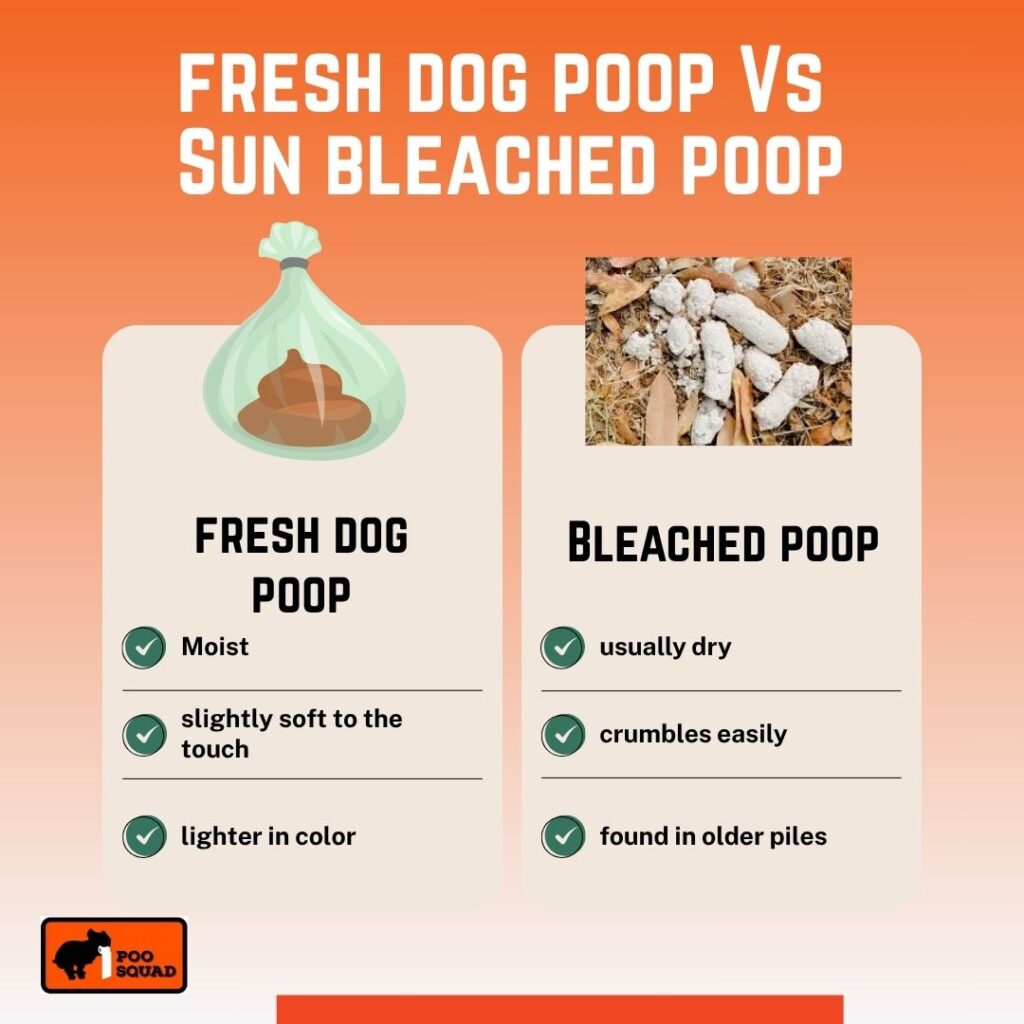
- Bleached poop is usually dry, crumbles easily, and is found in older piles.
- Internal issue poop is fresher, lighter in color from the start, and might be greasy or clay-like in texture.
If you’re unsure, scoop a sample and compare it to newer piles or monitor changes over the next few days. Staying consistent with cleanups helps you spot abnormalities early, before snow or sun get involved.
How Poo Squad Monitors Your Dog’s Health Through Their Poop
Most pet owners barely glance at it, trained eyes can spot problems early. That’s why ongoing service from professionals offers more than a clean yard, it’s peace of mind.
1. The Dog Poop Report Card
Teams track abnormalities like pale or white stools and notify clients when something doesn’t look right. The color, texture, and frequency of stool changes are logged discreetly.
One client shared, “We caught a liver issue early thanks to the poop report.” That’s not a fluke, it’s the result of consistent monitoring over time. Even subtle signs, like light yellow-gray stool or dry white clumps, don’t go unnoticed.
2. Gate Photos and Poop Pics
Every service visit includes photos of the closed and latched gate for security. But these snapshots do more than verify entry, they’re often used to document unusual poop findings when needed.
Images help track patterns from week to week. If poop starts off gray one visit and turns bone-white the next, that’s a signal worth catching. Having a visual log helps everyone involved make faster, more informed decisions.
What You Should Do If You Spot White Dog Poop
Seeing a pale or chalky pile in the backyard can feel alarming, but a clear response plan can make all the difference. Before hitting panic mode, follow a few simple steps.
1. Step-by-Step Owner Checklist
- Step 1: Review Recent Diet Changes – Think back, has your dog had a raw meal, large bone, or calcium-rich treat recently? High-calcium foods are a top cause of white poop, especially if it’s crumbly or dry.
- Step 2: Watch for Other Symptoms – Keep an eye on energy levels, appetite, and stool texture. Signs like vomiting, bloating, or lethargy alongside white stool are a prompt for faster action.
- Step 3: Check the Environment – Was the poop freshly dropped or left outside for days? UV light and snow can bleach poop white, making it look suspicious even when it’s not.
- Step 4: Contact a Vet if Poop Stays White – If the discoloration continues for more than 24–48 hours, or if your dog seems off, it’s time to call your vet. Chronic pale stool can indicate issues with bile, digestion, or liver function.
2. What to Tell Your Vet
You don’t need to know all the medical terms, give a clear picture.
Example:
“My dog’s poop has been chalky white for three days. There’s no vomiting or appetite change. He did chew on a bone last week. Should I bring him in?”
Bring photos if you’ve taken any. Services that document your dog’s waste over time, like poop report cards or weekly logs, can also provide helpful patterns for your vet to evaluate.
How to Prevent White Poop in the Future
You can’t control everything your dog eats or every health issue they may face, but you can build habits that reduce surprises and keep stool changes from slipping through the cracks.
1. Rethink Bones and Calcium Treats
Marrow bones, antlers, and raw-fed diets can be rewarding, but they’re also a major cause of pale, crumbly stools. Without balance, excess calcium from bones can lead to constipation and buildup in the gut.
It’s best to feed these under guidance from a vet or canine nutritionist. Dogs can enjoy variety, but moderation matters when it comes to high-mineral content.
2. Keep a Dog Poop Diary
It might sound odd, but noting changes in your dog’s poop can be surprisingly helpful. Track any diet changes, travel stress, illnesses, or medication that could influence digestion.
If you’re using a cleanup service that offers regular health reporting, lean on that data. Getting consistent updates builds a timeline you can share with your vet if needed, especially when white or off-color poop returns sporadically.
3. Dehydration & Environment Check
Dry, crumbly stools don’t always mean a medical issue. Environmental exposure. Frozen poop in winter or bleached piles under summer sun can appear chalky.
Make sure your dog’s water intake is steady, especially during weather shifts. Proper hydration helps keep the gut moving and the poop healthy.
When in Doubt, Poop It Out to the Pros
White poop might be harmless, or it might be the first sign something’s wrong. Either way, you don’t have to monitor it alone. With trained eyes scanning for red flags, photo logs, and consistency tracking, poop cleanup becomes more than a chore, it’s a checkup.
Want extra peace of mind? Schedule a visit and ask for a free Dog Poop Report Card. Schedule Your First Poop Report Visit Today
FAQs from Concerned Dog Owners
Can white poop hurt other dogs if they sniff or eat it?
Yes. Even if it looks dried out or “harmless,” old poop can still harbor bacteria or parasites, especially if it was caused by a health issue. Keep curious noses away.
How long does it take for poop to turn white in winter?
Usually 2–3 days, depending on exposure to sun, snow, and dry air. Poop left in the yard often changes color more from environment than digestion.
Is white poop normal in puppies?
Not usually. Because their systems are still developing, pale stool could mean digestive trouble or infection. It’s safer to check with a vet.
Why does my dog’s poop turn white only in the backyard?
Outdoor factors like sun bleaching, snow cover, or even de-icer chemicals can fade stool over time. Fresh poop should always be evaluated before assuming it’s nothing.
Author: Chief Scooper
Jamie Coones is the founder of Poo Squad. He started the original location in Manhattan, KS in 2017 and has since licensed the brand to another 20 other owners with locations across the country.
